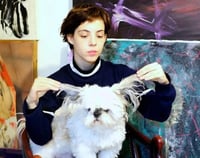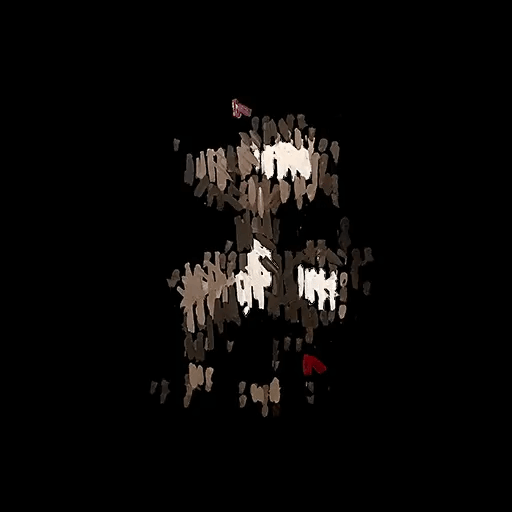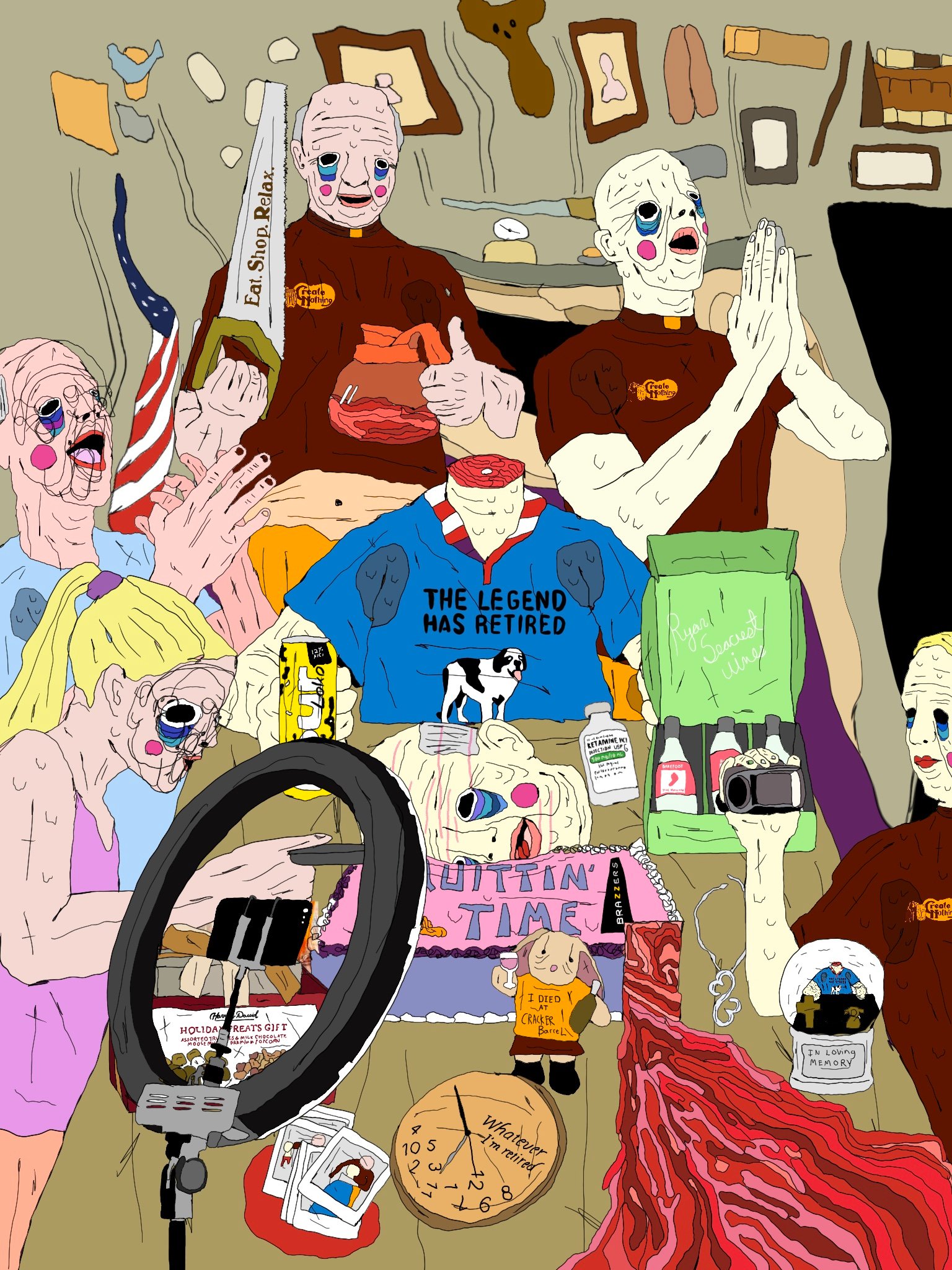Pindar Van Arman has been designing robots that paint with AI for almost 20 years. He programs them to mimic his own artistic process and collaborates with them to make artworks. In all his experimentation, he has come to understand creativity as the interplay between emotion and logic guided by reflection. To replicate this, he directs his robots to paint expressively and draw purposefully while analyzing their own progress, including their mistakes. Each new mark is dependent on the emerging artwork and all the marks that came before. The multimedia works he creates are artifacts of his true medium, which is machine-collaborative creativity, his artistic process codified. SuperRare curator Mika Bar-On Nesher interviewed Van Arman about his process and his latest 1/1, a SuperRare Curated Release titled “xeno skullGANg.”
Mika Bar-On Nesher: Tell us about how you first got into robotics?
Pindar Van Arman: Born an artist, trained as a painter, and became a programmer in the dot-com boom. My first foray into robotics was part of the DARPA Grand Challenge where the US Defense Department offered $1,000,000 to the fastest self-driving car to race across the Nevada desert. Worked on a car with 12 friends and ours had the fastest split times, but we ran into a Joshua Tree at 82 miles. Who puts trees in the middle of the desert? That unfortunately took us out of the race, but at least the project got me into AI and led to my first personal robotics project around 2005, which was a painting robot.
MBON: Your work is really unlike what anyone else is going in the space. You mentioned you are building two new painting robots, can you tell us about that process?
PVA: [I] Have been building collaborative painting robots for almost two decades. I design them to be collaborative and mimic my own artistic process. In all my tinkering, I have come to understand creativity as an interplay between emotion and logic with lots of reflection. This understanding closely matches one of the the best description of high art that I have ever heard which is:
"Art has the greatest impact when it makes the thinking part of the brain talk to the feeling part."
- Kirsten Ward
With this in mind, the creative process I have coded into my robots attempts to both think and feel, and explore the relationship between the two. They follow logical rules and paint expressively, all while continually photographing their own progress to make aesthetic decisions based on the emerging artwork. Sometimes they use neural nets to paint based on their imagination and other times they draw using technical direction. I have no idea the direction they will take when we begin each collaboration.
In short, the process of building my robots is the process of trying to codify my own creativity. Some say that my medium isn’t the multimedia artworks we produce, but machine-collaborative creativity itself.
 "Self Portrait 2023 - AI Imagined Faces (8/10)" by Pindar Van Arman, 2023.
"Self Portrait 2023 - AI Imagined Faces (8/10)" by Pindar Van Arman, 2023.
MBON: We see a lot of AI art made with deterministic algorithms, but your robots are far more independent, as they contain different minds with different agendas that vote on the final creative decisions in the painting. Can you tell us a bit about the 24 different "minds" that battle for the final decision making process in the paintings?
PVA: Until recently I described all the AI in my robots as 24 distinct creative minds battling for control of a paint brush. While true, I have found this explanation to be confusing, so I have simplified how I describe it. I now say:
My robots and I create art using a mix of emotionality and logic guided by reflection.
Their emotionality comes from their use of neural networks to imagine. As can be seen with prompt-based diffusion models, it has recently become difficult to detect the difference between AI art and traditional art. As controversial as it may sound, AI art now has an emotional element. The robot’s logic is guided by more traditional deterministic algorithms. These measure and rate technical aspects of the painting, like contrast and balance, and improve them if needed.
To help people visualize what the AI is thinking at any given point, the new robots have multiple heads that either paint with emotionality or draw using logic. Think of it as sort of a left-brain/right-brain duality battling it out on the canvas. One cool thing about this is that if you are wondering what motivated a specific mark, all you have to do is look at it. Painted brushstrokes come from the emotional programming (right brain), and the drawn lines come from its logical side (left brain).
Dualities are often an oversimplification of things, however, so I will briefly mention that the robot is also reflective, which I will get into more with the next question.
MBON: The robots you build take their own reference photos. Why is this important?
PVA: Artist Paul Klee once described creativity as an artist making a mark, stepping back to analyze the mark, and making the next mark based on that analysis, in a creative feedback loop.
Since around 2010, my robots have been taking photographs of their progress so they can take advantage of these creative feedback loops. I have long talked about this as feedback loops, but have since changed to the more understandable concept of reflection. With every mark, whether it be an expressive brushstroke or precisely drawn line, the robot is reflecting on the mark and its effect on the overall artwork. It then uses this analysis to decide on what kind of mark to make next. Sometimes it might decide to paint something chaotic like a bold red brushstroke. Other times it might decide to draw something precise like a contrast enhancing line. Why this is important is that it is a generative algorithm that is generating the art based on how the artwork is progressing, which is exactly how I create art.
I will repeat what I have learned about making a successful piece of art. Fine art is a mix of emotion and logic guided by reflection. Reflection is key to finding a balance between the emotion and logic. Achieving this balance is the goal of my collaborative work with my robots..gif?width=562&height=562&name=download%20(1).gif)
"cyber skullGANg" by Pindar Van Arman, 2023.
MBON: Can you share with us some context about this release?
PVA: My latest release is “xeno skullGANg.” On the surface it is a rendition of a new and unique type of byteGAN. byteGANs, and their bitGAN brethren, are a mysterious breed of AI that have revealed themselves to me over the past couple of years. They have begun taking over my computers, robots, and life as their story unfolds in my Discord and on bitgans.com.
Under the surface, “xeno skullGANg” is the culmination of many of my artistic paths over the last 20 years. This includes elements of both my stylistic and technical progression.
Stylistically, the art has undergone a full split where I have recognized that my digital and physical art are two distinct things. This work has a purely digital element, the NFT on SuperRare, and a physical twin which was created by Feedback, my latest robot. The NFT emphasizes its digital nature with bright electric colors and a dancing neural net produced animation. The physical canvas is a multimedia piece with spray paint, acrylic paint, and multiple markers that was made collaboratively with my robots. Technically, it is the most detailed work my robots have ever produced. Emotionally, it is the most I have ever collaborated with them.
Beyond the collaborative element, the multimedia is the first artwork created by one of my new robots where emotionality and logic have been split onto different robot heads, making it clear which of the approaches is being used at any given moment. This is a big step for my art, but the digital innovation is an even bigger step. This is that “xeno skullGANg” is 100% On-Chain, which I will go into more when I answer your next question.
MBON: Your very medium is the blockchain, can you explain to people unfamiliar what it entails to create artworks that are 100% on chain?
PVA: As just mentioned, “xeno skullGANg” is 100% on-chain, or fully on-chain as some say. This means a very specific thing that is extremely rare, expensive, and hard to do. To be 100% on-Chain, all of the art and code in a piece must be stored and accessible on-chain with 0 links to anything off-chain. This means that the artwork in its entirety is literally inscribed on the Ethereum blockchain, where in effect, the blockchain is the medium. All byteGANs are 100% on-chain, and while I don’t think firsts are important, I have been told by multiple credible sources that it is the first 100% on-chain AI art project.
For people wondering why 100% on-chain art is so rare, there are many reasons. The two biggest are that it is expensive and that it requires expertise with writing custom smart contracts. My experience is that it costs about 0.01 ETH per KB to inscribe something on-chain. At this price a 10 MB artwork would cost 100 ETH. To get around the high price, there are a couple things you can do to compress and store the art in clever manners, but this becomes extremely technical and not many artists want to bother going deep into the Solidity code. But I am one of those artists, and I did create a custom contract and am proud of the fact that my byteGANs began as 10 MB images which were compressed and stored in clever ways to minimize their size on the Ethereum Blockchain. Even though I invented new ways of compressing the art while still maintaining their aesthetics, inscribing the byteGANs has cost more than 40 ETH to date. I have done so, despite the costs, because I think it is an important aspect for their character as “dancing coins.”
If you want to see how the art is stored on-chain for yourself, follow this link to the contract on Etherscan.
You will see a function called “artOnChain.” Click on that function and enter “5,” “xeno skullGANg’s” token number. Etherscan will return the BASE64 image exactly as it was inscribed onto the Blockchain. Copy and paste this long string from start to finish into your browser's search bar. You should then be able to see the image in your browser.
In the five years I have been a cryptoArtist on SuperRare, I have gone from using acrylic paint on canvas as my medium, to using the Blockchain itself. “xeno skullGANg” is a digital work that is so digital, it doesn’t even have an image file.
 “xeno skullGANg” by Pindar Van Arman, 2023.
“xeno skullGANg” by Pindar Van Arman, 2023.
MBON: What is the most surprising thing that happened to you working with these tools? How do you see the relationship between AI and human creativity will evolve in the next several years? What will we think looking back at this point in time?
PVA: Working on machine-collaborative creativity, the most surprising thing to happen is the realization that all art is probably generative art, even art by traditional studio artists. As I have built up the sophistication of my collaborative robots to mimic my creativity, they have gotten so sophisticated that they themselves are creative. Are they artists? Of course not, but they are creative and have a creative process on par with humans.
If you doubt this, think of what makes an artist famous. It is often a consistent recognizable style. Take Jackson Pollock as an example. He and people that write about him often focus on the importance of his creative process. He dripped paint on a canvas in equal portions to create similar looking masterpieces. This technique is a generative algorithm that he followed and repeated in his studio. Further evidence that it was a generative algorithm is that I have seen at least three different robots execute the algorithm over the years. One robot named pollock-bot did it so well that one couldn’t detect the difference between the counterfeit and originals.
Compared to other artists, one could argue Pollock had a simple generative art process that is relatively easy to counterfeit. And that while Pollock’s could be reverse engineered and executed by robots, more complex artists like Basquiat would be impossible to codify. But even complex processes can now be imitated by AI as demonstrated by my robots and prompt-based AI Art generators like Stable Diffusion. If you do not accept this, go to a prompt based image generator like Stable Diffusion and end any prompt with “in the style of Basquiat.” The AI will return an image in the style of Basquiat.
What is surprising to me, is what this means about human creativity and beyond that, what it means to be human. When I think too hard about it, it takes me to places I don’t want to go. I sometimes wonder if my creativity is purely generative, a collection of deterministic algorithms and AI repeating itself in my mind? And if that is the case, I wonder if all my thoughts are just deterministic algorithms playing themselves out as I powerlessly observe myself going about my day?
I am not there yet, but the more I work on machine-collaborative art, the closer I get to this conclusion.
You can find “xeno skullGANg” on SuperRare here.




